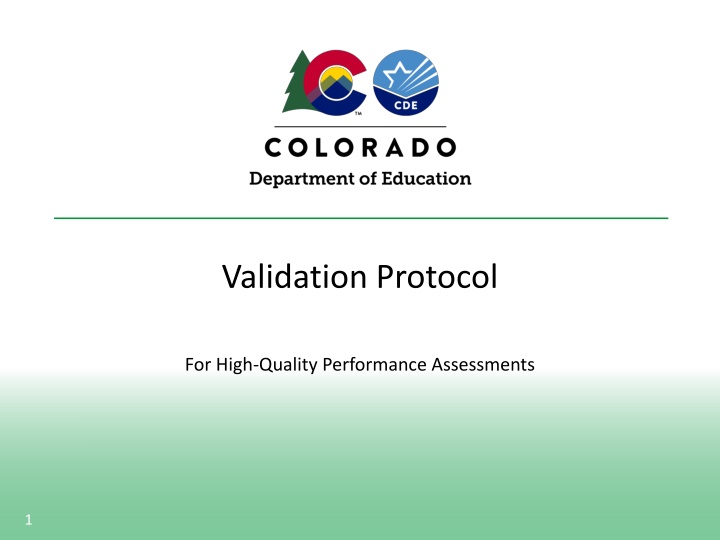
High-Quality Performance Assessments Protocol
Explore a validation protocol for high-quality performance assessments, involving task design, analysis, calibration, and rubric creation within the assessment cycle. Gain insights on preparation, roles during the protocol, review norms, and adapt assessment validation protocols for effective feedback mechanisms.
Download Presentation

Please find below an Image/Link to download the presentation.
The content on the website is provided AS IS for your information and personal use only. It may not be sold, licensed, or shared on other websites without obtaining consent from the author. If you encounter any issues during the download, it is possible that the publisher has removed the file from their server.
You are allowed to download the files provided on this website for personal or commercial use, subject to the condition that they are used lawfully. All files are the property of their respective owners.
The content on the website is provided AS IS for your information and personal use only. It may not be sold, licensed, or shared on other websites without obtaining consent from the author.
E N D
Presentation Transcript
Validation Protocol For High-Quality Performance Assessments 1
The Performance Assessment Cycle Task Design Analysis Calibration Validation Instruction Rubric Design 2
Validation Task Design Engage in a structured protocol to get feedback from colleagues on the extent to which the draft task meets the design criteria Analysis Calibration Validation Instruction Rubric Design
The Performance Assessment Cycle is an iterative design process, requiring educators to engage in a cycle of drafting, implementing, gathering data, and refining. LATER NOW This first round of validation is meant to provide early feedback to facilitate multiple iterations in a short period of time. Final validation requires examination of all supporting documents and materials necessary to fully implement the task with learners. 3
Preparing for Protocol: PRESENTER LOGISTICS Create copy of protocol form; feel free to add a few questions to address your personal growth needs Reflect on your task: Is there a particular aspect of my product that may need an explicit voice over for others to be able to best provide feedback? 5
During Protocol: ROLES Facilitator: ensure participants have the necessary links/ documents, review norms, elect timekeeper, follow protocol as outlined in google form Participants: open the 6 Design Elements for High Quality Performance Assessments Rubric PRESENTER: share your link to your google form in the chat/via email 6
Validation Protocol Adapted from QPA s Tool 3: Assessment Validation Protocol 6
1. Review Norms: 2 minutes Be present Embrace the opportunityto learn from and with others Model vulnerability and professional risk-taking Assume positive intentions Prepare to give/receive feedback as catalyst for growth and not as judgement 8
2 - 4. Examine the Task 2. Presentation (5 minutes) 3. Examination (10 minutes) 4. Clarification (5 minutes) Participants silently examine all of the materials The team asks for any needed clarification (materials, process) from the presenter Designer provides context and overview of the task Walks participants through the materials 9
5 - 6. Feedback and Reflection 5A. Independent Scoring (10 minutes) 5B. Score Consensus (20 minutes) 6. Reflection (5 minutes) Presenter takes notes while the facilitator asks participants to share responses and explanations. The goal is to reach 80% consensus on each item. Responses are submitted. The presenter shares response to feedback. What comments particularly resonated? Do you have questions for the team? Participants score the task using the feedback form sent by the presenter, but DO NOT submit the form 9
7. Debrief: 3 minutes Did we follow the norms at all times? What went well? What could have gone better? What are the implications of what we learned? 10
After the Protocol: PRESENTER REFLECTION Connect to community needs: Are there specific systemic/ institutional structures that may prevent my students from being successful with this task? How can school and class culture support students with this task? What pedagogies would best support students as they complete this task? Reflect on feedback from the protocol: What opportunities are there to more closely align with the 6 Design Elements? Seek additional feedback: Are there additional individuals/stakeholders whom I would like to connect to get their feedback? Revise as necessary 11
The Performance Assessment Cycle Task Design Analysis Calibration Validation Instruction Rubric Design 13






















